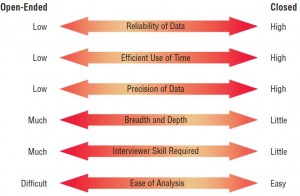Open-ended Questions
Open-ended questions include those such as “What do you think about putting all the managers on an intranet?” “Please explain how you make a scheduling decision.” “In what ways does the system extend your capability to do tasks that would not be possible otherwise?” Consider the term open-ended. “Open” actually describes the interviewee’s options for responding. They are open. The response can be two words or two paragraphs. Some examples of open-ended questions are shown below.
| Open-Ended Interview Questions |
|---|
|
Open-ended interview questions allow the respondent open options for responding. The examples were selected from different interviews and are not shown in any particular order.
The benefits of using open-ended questions are numerous and include the following:
- Putting the interviewee at ease.
- Allowing the interviewer to pick up on the interviewee’s vocabulary, which reflects his or her education, values, attitudes, and beliefs.
- Providing richness of detail.
- Revealing avenues of further questioning that may have gone untapped.
- Making it more interesting for the interviewee.
- Allowing more spontaneity.
- Making phrasing easier for the interviewer.
- Using them in a pinch if the interviewer is caught unprepared.
As you can see, there are several advantages to using open-ended questions. There are, however, also many drawbacks:
- Asking questions that may result in too much irrelevant detail.
- Possibly losing control of the interview.
- Allowing responses that may take too much time for the amount of useful information gained.
- Potentially seeming that the interviewer is unprepared.
- Possibly giving the impression that the interviewer is on a “fishing expedition” with no real objective for the interview.
You must carefully consider the implications of using open-ended questions for interviewing.
Closed Questions
The alternative to open-ended questions is found in the other basic question type: closed questions. Such questions are of the basic form “Is it easy to use the current system?” and, “How many subordinates do you have?” The possible responses are closed to the interviewee, because he or she can only reply with a finite number such as “None,” “One,” or “Fifteen.” Some examples of closed questions are listed below.
| Closed Interview Questions |
|---|
|
Closed interview questions limit the respondent’s options. The examples were selected from different interviews and are not shown in any particular order.
A closed question limits the response available to the interviewee. You may be familiar with closed questions through multiple-choice exams in college. You are given a question and five responses, but you are not allowed to write down your own response and still be counted as having correctly answered the question.
A special kind of closed question is the bipolar question. This type of question limits the interviewee even further by only allowing a choice on either pole, such as yes or no, true or false, agree or disagree. Examples of bipolar questions are listed below.
| Bipolar Interview Questions |
|---|
|
Bipolar interview questions are a special kind of closed question. The examples were selected from different interviews and are not shown in any particular order.
The benefits of using closed questions of either type include the following:
- Saving time.
- Easily comparing interviews.
- Getting to the point.
- Keeping control over the interview.
- Covering lots of ground quickly.
- Getting to relevant data.
The drawbacks of using closed questions are substantial, however. They include the following:
- Being boring for the interviewee.
- Failing to obtain rich detail (because the interviewer supplies the frame of reference for the interviewee).
- Missing main ideas for the preceding reason.
- Failing to build rapport between interviewer and interviewee.
Thus, as the interviewer, you must think carefully about the question types you will use. Both open-ended and closed questions have advantages and drawbacks, as shown in the figure below. Notice that choosing one question type over the other actually involves a trade-off; although an open-ended question affords breadth and depth of reply, responses to open-ended questions are difficult to analyze.

Probes
A third type of question is the probe or follow-up. The strongest probe is the simplest: the question, “Why?” Other probes are “Can you give me an example of a time you did not find the system trustworthy?” and “Will you elaborate on that for me?” Some examples of probing questions are listed below. The purpose of the probe is to go beyond the initial answer to get more meaning, to clarify, and to draw out and expand on the interviewee’s point. Probes may be either open-ended or closed questions.
| Probes |
|---|
|
Probes allow the systems analyst to follow up on questions to get more detailed responses. The examples were selected from different interviews and are not shown in any particular order.
It is essential to probe. Most beginning interviewers are reticent about probing and consequently accept superficial answers. They are usually grateful that employees have granted interviews and feel somewhat obligated to accept unqualified statements politely.
Contents
- Interviewing in Information Gathering
- Five Steps in Interview Preparation
- Open-Ended and Closed Type Interview Questions
- Arranging Interview Questions in a Logical Sequence
- Joint Application Design (JAD) in Information Gathering
- Using Questionnaires in Information Gathering
- Writing Questions for Questionnaires
- Using Scales in Questionnaires
- Designing and Administering the Questionnaires
